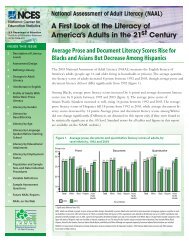Adult Literacy in America - National Center for Education Statistics ...
Adult Literacy in America - National Center for Education Statistics ...
Adult Literacy in America - National Center for Education Statistics ...
You also want an ePaper? Increase the reach of your titles
YUMPU automatically turns print PDFs into web optimized ePapers that Google loves.
6 ......Introduction<br />
oversampled to ensure reliable estimates of literacy proficiencies and to permit<br />
analyses of the per<strong>for</strong>mance of these subpopulations.<br />
To give states an opportunity to explore the skill levels of their<br />
populations, each of the 50 states was <strong>in</strong>vited to participate <strong>in</strong> a concurrent<br />
assessment. While many states expressed an <strong>in</strong>terest, 11 elected to participate<br />
<strong>in</strong> the State <strong>Adult</strong> <strong>Literacy</strong> Survey. Approximately 1,000 adults aged 16 to 64<br />
were surveyed <strong>in</strong> each of the follow<strong>in</strong>g states:<br />
Cali<strong>for</strong>nia Louisiana Pennsylvania<br />
Ill<strong>in</strong>ois New Jersey Texas<br />
Indiana New York Wash<strong>in</strong>gton<br />
Iowa Ohio<br />
To permit comparisons of the state and national results, the survey <strong>in</strong>struments<br />
adm<strong>in</strong>istered to the state and national samples were identical and the data were<br />
gathered at the same time. Florida also participated <strong>in</strong> the state survey, but its<br />
data collection was unavoidably delayed until 1993.<br />
F<strong>in</strong>ally, more than 1,100 <strong>in</strong>mates <strong>in</strong> some 80 federal and state prisons<br />
were <strong>in</strong>cluded <strong>in</strong> the survey. Their participation helped to provide better<br />
estimates of the literacy levels of the total population and make it possible to<br />
report on the literacy proficiencies of this important segment of society. To<br />
ensure comparability with the national survey, the simulation tasks given to the<br />
prison participants were the same as those given to the household survey<br />
population. However, to address issues of particular relevance to the prison<br />
population, a revised version of the background questionnaire was developed.<br />
This <strong>in</strong>strument drew questions from the 1991 Survey of Inmates of State<br />
Correctional Facilities sponsored by the Bureau of Justice <strong>Statistics</strong> of the<br />
U.S. Department of Justice. These <strong>in</strong>cluded queries about current offenses,<br />
crim<strong>in</strong>al history, and prison work assignments, as well as about education and<br />
labor <strong>for</strong>ce experiences.<br />
Responses from the national household, the state, and prison samples<br />
were comb<strong>in</strong>ed to yield the best possible per<strong>for</strong>mance estimates. Un<strong>for</strong>tunately,<br />
because of the delayed adm<strong>in</strong>istration, the results from the Florida state survey<br />
could not be <strong>in</strong>cluded <strong>in</strong> the national estimates. In all, more than 26,000 adults<br />
gave, on average, more than an hour of their time to complete the literacy<br />
tasks and background questionnaires. Participants who completed as much<br />
of the assessment as their skills allowed were paid $20 <strong>for</strong> their time. The<br />
demographic characteristics of the adults who participated <strong>in</strong> NALS are<br />
presented <strong>in</strong> Table 1.



